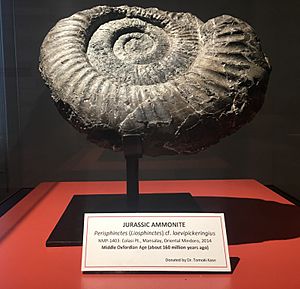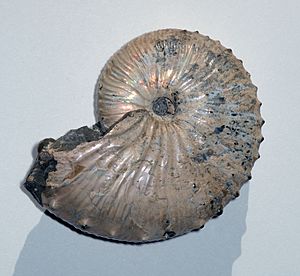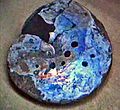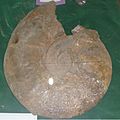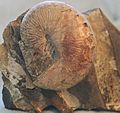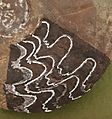Ammonite facts for kids
Quick facts for kids AmmonoiteTemporal range: Devonian – Cretaceous
|
|
|---|---|
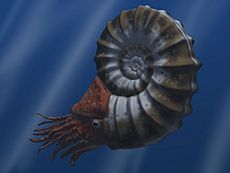 |
|
| Asteroceras | |
| Scientific classification | |
| Kingdom: | |
| Phylum: | |
| Class: | |
| Subclass: |
Ammonoidea
|
| Orders | |
|
Anarcestida; Clymeniida; Goniatitida; Prolecanitida; Ceratitida; Phylloceratida; Lytoceratida; Ammonitida; Ancyloceratina |
|
Ammonites are a group of extinct marine mollusc animals cephalopod molluscs of the subclass Ammonoidea.
These creatures lived in the seas from at least 400 to 65 million years ago. They became extinct at the K/T extinction event. They are excellent index fossils, and it is often possible to link the rock layer in which they are found to specific geological time periods.
Nine orders are recognized in the Ammonoidea: five in the Palaeozoic and four in the Mesozoic.
Their nearest living relatives are the octopus, squid, cuttlefish and Nautilus.
Ammonites' widely-known fossils show a ribbed spiral-form shell, in the end compartment of which lived the tentacled animal.
Their name came from their spiral shape as their fossilized shells somewhat resemble tightly-coiled rams' horns. Pliny the Elder (d. 79 A.D. near Pompeii) called fossils of these animals ammonis cornua ("horns of Ammon") because the Egyptian god Ammon (Amun) was typically depicted wearing ram's horns.
Contents
Evolution
Ammonites first appeared in the early Devonian period. They evolved from what was an early Nautiloid. They quickly evolved into a variety of shapes and sizes. During their evolution the ammonites faced no fewer than four catastrophic events that would eventually lead to their extinction.
The first event occurred in the Upper Devonian, and the second at the end of the Permian (250 million years ago). The surviving species radiated and flourished throughout the Triassic period. At the end of this period (206 million years ago) they faced near extinction again, when only one species survived.
This event marked the end of the Triassic and the beginning of the Jurassic, during which time the number of ammonite species grew once more. The final catastrophe occurred at the end of the Cretaceous period when all species were annihilated and the ammonites became extinct.
Description
Ammonites began life as tiny creatures less than 1mm in diameter. In their infancy they would have been vulnerable to attack from other predators, including mosasaurs and fish. However, their shell gave their soft parts some protection.
The young ammonites lived in the plankton, near the sea surface. They ate mostly small fry as they were growing. This made them especially vulnerable to any event which upset the plankton zone.
Ammonites swam by jet propulsion, as do most other cepalopod's. Water would have come into the mantle cavity, passed over the gills, and was squirted out.
Ammonites vary greatly in the decoration (surface relief) of their shells. Some may be smooth and relatively featureless, except for growth lines, and resemble that of the modern Nautilus. In others, various patterns of spiral ridges and ribs or even spines are shown. This type of ornamentation of the shell is especially evident in the later ammonites of the Cretaceous.
Few of the ammonites occurring in the lower and middle part of the Jurassic period reached a size exceeding 23 centimetres (9 inches) in diameter. Much larger forms are found in the later rocks, such as Titanites from the Portland Stone of Jurassic of southern England, which is 53 centimetres (2 feet) in diameter, and Parapuzosia seppenradensis of the Cretaceous period of Germany, which is one of the largest known ammonites, reaching 2 metres (6.5 feet) in diameter.
The largest documented North American ammonite is Parapuzosia bradyi from the Cretaceous with specimens measuring 137 centimetres (4.5 feet) in diameter.
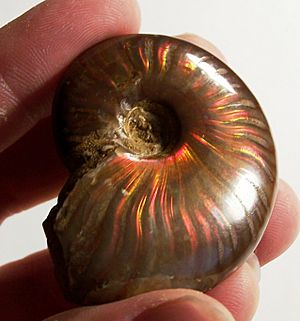
Fossils, such as many found in Madagascar and Alberta (Canada), display iridescence. These iridescent ammonites are often of gem quality (ammolite) when polished. In no case would this iridescence have been visible during the animal's life; additional shell layers covered it.
The ammonoids as a group continued through several major extinction events, although often only a few species survived. Each time, however, this handful of species diversified into a multitude of forms.
Ammonite fossils became less abundant during the latter part of the Mesozoic, with none surviving into the Cenozoic era. The last surviving lines disappeared along with the dinosaurs 65 million years ago in the Cretaceous-Tertiary extinction event.
Images for kids
-
Iridescent ancient ammonite fossil on display at the American Museum of Natural History, New York City, around 2.5 feet in diameter
-
Fossil shell of ammonite Placenticeras whitfieldi showing punctures caused by the bite of a mosasaur, Peabody Museum of Natural History, Yale
-
A variety of ammonite forms, from Ernst Haeckel's 1904 Kunstformen der Natur (Art Forms of Nature)
-
Baculites ammonite from the Late Cretaceous of Wyoming, US: The original aragonite of the outer conch and inner septa has dissolved away, leaving this articulated internal mold.
-
A drawing of an aptychus which was mistakenly described as a bivalve and given the name "Trigonellites latus", from the Kimmeridge Clay Formation in England
-
Ammonoidea in Iran
-
A specimen of Hoploscaphites from the Pierre Shale of South Dakota, US: Much of the original shell, including the nacre, has survived.
-
Goniatites plebeiformis showing Goniatitic suture
See also
 In Spanish: Ammonites para niños
In Spanish: Ammonites para niños


